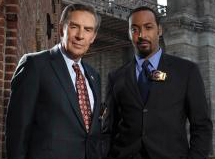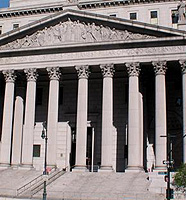July 11, 2005
Feature
New York's Real Law and Order
Dunh-dunh.
Law
The scene: a young woman is walking down a dark New
York City street
at night,
her arms full of grocery bags. She's minding her own
business and
whistling
to herself until an SUV pulls up and a man leans out
with a gun in his
hand.
The man opens fire on the building on the corner,
killing a teenage
boy who
had been loitering near the entrance. The woman drops
her grocery
bags, food
spilling on the sidewalk, and gasps, "Oh, my
God!"
Or, that's what would have happened if it hadn't been sunny out and I had gotten home twenty minutes earlier, or if this had been the opening sequence of an episode of Law & Order.
I've lived in New York for nearly three years, and the only encounters I ever have with violent crime are usually in my living room, on my TV. So it was quite shocking to come home after work one evening to find police tape surrounding my block.
| He was definitely of the older-cop-who's-seen-too-much-and-might-be-a-recovering-alcoholic variety (see also: Cragen, Fontana, and the aforementioned Briscoe), but he came looking for clues wearing jeans and a green t-shirt, with his badge on a chain around his neck. |
This made me wonder about Law & Order in general, and how accurately it depicts my city. Of all the shows on TV, I always thought L & O showed the city I know better than any other. This is probably because they shoot in New York. I often recognize the street scenes in the background, so it looks like home. So many New York-based TV shows and movies (Friends, for instance, or CSI: New York, aside from a few exterior shots) shoot on a set or on a back lot in LA fashioned after the Big Apple. And, if you know New York, you can tell. It's just not the same.
L & O has also woven itself into the tapestry of the city in ways no other television show ever has. It's become kind of an acting rite-of-passage; if you ever go to a play in New York, you can count on at least half the cast boasting parts on L & O or one of its spin-offs in their "Who's Who" biographies at the back of the Playbill. It's also fairly commonplace to walk through a set, because they film right there, out on the street. It was with some measure of joy that I walked outside my apartment one morning and found fliers taped over all the parking meters on the block announcing that Law & Order: Criminal Intent would be filming there for two days, so no one was allowed to park. An inconvenience for some, sure, but dude. They were shooting a TV show on my block. (Which, to me, is cooler than that time my friend and I stumbled through an Apprentice task. Yeah, my friend got to be on TV for two seconds, but so did everyone else who was in Times Square that weekend. This was filming on my street, and I don't even live in a trendy neighborhood.)
 |
Further, how is it that these cops travel all over the city? Officers are usually confined to their precinct, but then Fontana and Green (or whoever this Italian guy is that they've got subbing for Green while Jesse L. Martin films the Rent movie... I mean, while Green is in a coma) would run out of crime pretty fast. Their precinct, the 27th, doesn't actually exist, but in the 26th precinct, presumably nearby, there were only 5 murders last year.
Not to mention that the sum total of all marchers in the parade of serial killers over the many years the show has been on the air probably outnumbers all of the real-life, genuine serial killers there have been throughout history. That sort of antisocial disorder is extremely rare, but it's common fodder for an episode of everyone's favorite crime drama.
This is not to say that the show doesn't deal with real issues or real crimes, because it does, and that's why I find it so compelling. Even the ripped-from-the-headlines episodes, despite the sometimes farcical connections the show makes to real-life news stories, often ring true-to-life.
It's just odd; New York is enjoying the lowest crime rate it's had in years, but you'd never know that if you watched L & O regularly.
(Incidentally, the homicide detectives in my neighborhood caught the guy. It wasn't that hard, since there were a lot of witnesses. And it turned out to not be a random shooting, as the police guessed initially, because the shooter knew the kid he shot. Drugs were involved. Maybe not as juicy as these things tend to be on TV, but still out of the ordinary in my mostly residential neighborhood.)
Order
A few weeks ago, I was summoned to serve jury duty at
the New York
County criminal
court. It's too bad I didn't get picked to serve on a
jury, because
I think it would have been fun. Then again, my
expectations might be
inflated
a bit; I'd go for the Jack McCoy-style theatrics and
the wildly
contrived
mental defect defense, and I'd likely come away
disappointed.
 |
That building with the columns, based on what I can tell from closely examining exterior shots on the show, seems to actually be the federal courthouse. Good choice, generally; it's a much nicer building to look at. Not exactly factually accurate, though.
I assume, anyway. McCoy must represent New York County, because our plucky detectives never end up in the boroughs unless they're pursuing a suspect, and they're always trying to extradite prisoners from, like, Canada or New Jersey. (Non-New Yorkers may not know that there's a weird phenomenon afoot in the city; normally, cities fall within counties which fall within states which fall within the country. In New York City, each borough is its own county, so 5 counties make up the city. Weird, eh? New York County is solely the island of Manhattan, plus, according to the jury clerk, Roosevelt Island and a tiny slip of the Bronx.)
There were celebrities and bad actors at jury duty, though. Orientation includes an unintentionally hilarious video hosted by Ed Bradley and Diane Sawyer, among others, illustrating the whole world history of the justice system and also how neat it is to be a juror. There's a whole courtroom scene, too, to illustrate the juror's role in the proceedings, but I'll say, it's a little dull.
It was neat to get an inside view of New York's justice system, but I'll tell you: it's a lot more boring in real life than it is on TV.
Dunh-dunh
So, basically what we've got here is the most New
York of shows that
isn't
even really an accurate reflection of how law & order
works in this
city.
That's okay, really, because I suspect every day legal proceedings or, alternately, the life of an average New Yorker might make for mundane television. Then again, if there's one thing New York is not, it's mundane. On any given day, you can walk past a park full of people dressed as cows to promote a new coffee cream (that's where the actors who can't get a job after L & O end up, I'll bet), ladies doing yoga on the sidewalk, numerous religious groups trying to convert you, and a guy in a chicken suit handing out menus for the restaurant down the street. Residents don't own cars and the police sometimes ride horses. Restaurants put arugula on everything, then top it with goat cheese. Within a few blocks of where I'm currently sitting, there are three Starbucks, several falafel carts, a guy on the corner who sells fresh fruit out of a box, homeless people with their life stories written thoughtfully on cardboard signs, several of the most expensive and most famous stores in the world, and also Times Square, Grand Central Station, and the New York Public Library. And, like, people live here, among some of the most iconic landmarks in America, walking past them every day as if each were just another building. It's a weird place.
| We look away when odd things happen on the subway, we buy groceries in overpriced bodegas that only take cash, and it's not uncommon to find a tiny studio apartment sandwiched between the apartments of a Hasidic man on one side and a tiny Chinese woman on the other. |
Law & Order is still more successful than other shows at depicting life in New York, though, because it depicts the every day folk that live here. We look away when odd things happen on the subway, we buy groceries in overpriced bodegas that only take cash, and it's not uncommon to find a tiny studio apartment sandwiched between the apartments of a Hasidic man on one side and a tiny Chinese woman on the other. Despite the inaccuracies, I see a lot of familiarity on L & O.
And I live for the Briscoe one-liner right before the opening credits. RIP, Jerry Orbach.
Email the author.
All written content © 2005 by the authors. For more information, contact homer@smrt-tv.com
